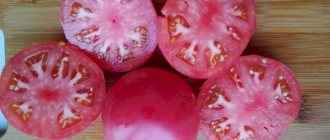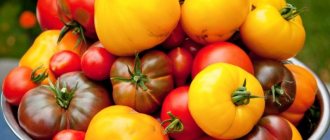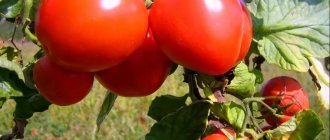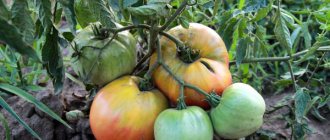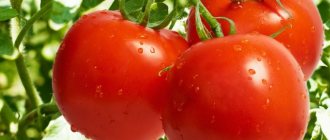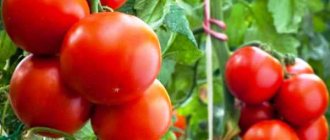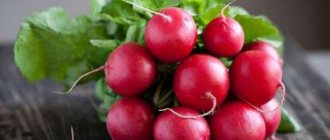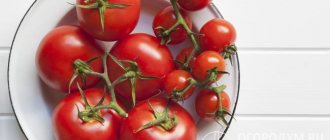Mahitos tomatoes belong to the hybrid group. This variety moved to Russia from Holland and quickly won the love of summer residents. Gardeners liked the hybrid with an exotic name for its excellent taste and unpretentiousness. During the growth process, Makhitos forms powerful bushes of indeterminate type. These tomatoes are harvested early. The fruits can not only be eaten fresh, but also used for preparations.
Description of Machitos tomatoes
Tomato Makhitos of medium early ripening (90-100 days from sowing the seeds) was created in Holland. It entered Russian stores in 2012 after being included in the State Register.
Mahitos tomatoes are indeterminate type, high-yielding. Since the height of the shoots reaches 1.8-2.5 m, a garter is necessary throughout the entire growing period. The bush itself has a powerful rhizome, but to get a decent harvest it is recommended to leave only two stems, otherwise the tomatoes will not have enough nutrition.
The hybrid has an interesting feature - cold weather and sudden temperature changes do not affect the formation of ovaries
Machitos tomato bushes are distinguished by dark green, elastic leaves with delicate velvety pubescence. The shape of the leaf blades is standard. The peculiarity of the culture is a large number of leaves. As for the green mass, it must be removed carefully. Experienced gardeners recommend not to be overzealous with picking, since thanks to the foliage the fruits are cooled and the sun does not burn them. Only those located at the very bottom are plucked to ensure air circulation.
Important! If you pick off a large amount of greenery, the plants may stop developing.
Inflorescences are formed over 4-5 leaves in steps of two internodes. Large bright yellow flowers are clearly visible on the racemes. The setting rate is almost 100%, since Mahitos tomatoes are self-pollinating plants.
Leaves for tomato Mahitos - cooling and moisture-permeable system
Description of fruits
The Makhitos hybrid is famous for its large tomatoes weighing 200-300 g, but if all agrotechnical standards are observed, heavier specimens can be obtained. Tomatoes have a rounded-flattened shape and become bright red when ripe. The surface of Mahitos tomatoes is shiny. There is a small depression where the stalk is located.
Makhitos F1 tomatoes have a rich aroma, taste sweet, and the acid is practically not noticeable. It's all about having a lot of sugar.
Tomato varieties collected in a greenhouse are much tastier and more aromatic than those grown in open ground.
Tomato Mahitos has a thick, dense skin and juicy pulp. Each fruit has 4-6 seed chambers. Not much liquid.
Farmer reviews
Makhitos f1 tomatoes have been highly appreciated by large farmers and amateur gardeners due to their excellent taste, productivity and relative ease of care.
Victoria, Pechory, Pskov region : “The Makhitos hybrid made a real splash in our region several years ago. Raspberry tomatoes flooded the markets, and red ones lost popularity. The situation has changed dramatically with the appearance of the seeds of this hybrid on our market. Tomatoes have an amazing taste, they are suitable for making salads and winter twists. Caring for the crop is simple; The main thing is to follow the manufacturer’s recommendations - do not overwater or overfeed.”
Kirill, Bataysk, Rostov region: “I am engaged in growing tomatoes for sale. Machitos are on the list of favorites. I have been planting it in a greenhouse for three years in a row. Last year I planted several bushes in the garden as an experiment. Culture loves the sun, so in our conditions this is permissible. The technology is the same as in a greenhouse. The yield was lower, but the tomatoes were much tastier, sweeter and the color was uniform. I know that some farmers feed tomatoes with growth hormones to form a “spout,” but I think this is unnecessary. The fruits have an excellent presentation even without this.”
Characteristics of Machitos tomatoes
The Machitos tomato variety attracts gardeners not only with its high yield, but also with many advantages. This is important for choosing a new crop on the site.
Machitos tomato yield and fruiting
The fruits begin to ripen 3-3.5 months after sowing the seeds for seedlings. By this time, about 95% of the tomatoes on the bunches will turn red. From 1 sq. m when grown in a greenhouse, up to 8 kg of delicious tomatoes are harvested.
In order for all the flowers on the Machitos hybrid to set, you need to monitor the temperature in the greenhouse: when readings are above 40 degrees, the inflorescences fall off, which negatively affects the yield.
Area of application of fruits
Hybrid Machitos is an excellent tomato for creating culinary delights, since its purpose is universal:
- as a cut for preparing fresh salads;
- for squeezing juice;
- cooking tomato paste;
- small fruits are used for preservation;
- excellent raw material for sauce, ketchup.
Resistance to diseases and pests
According to the description and characteristics given by the originators, the Makhitos tomato has high immunity to many crop diseases. In particular, they are rare:
- verticillium;
- fusarium wilt;
- cladosporiosis;
- tobacco mosaic virus;
- powdery mildew.
Attention! If the plants are sick, then the cause must be sought in violation of agricultural cultivation techniques.
The most common pest on the Makhitos tomato is aphids, which can be gotten rid of using:
- fermented milk solution of wood ash;
- potassium permanganate dissolved in water (per 5 liters - 1 g).
Analogs
| Variety name | Peculiarities |
| Afen | Mid-season Dutch hybrid for greenhouses with a yield of 9 kg/sq. m. With good care, the weight of the fruit reaches 300-350 g. |
| Bomax | Indeterminate hybrid with red fruits weighing 200 g each. Withstands transportation and storage very well. |
| Phizuma | Dutch hybrid for greenhouses. Productivity – up to 40 kg/sq. m. Almost never gets sick. The average fruit weight is 140 g. |
| Belfast | Cold-resistant hybrid from the Netherlands with fruits weighing up to 370 g. Gives a good harvest even with insufficient lighting. |
| Pozzano | Hybrid variety of Dutch selection of the mid-season group. Fruit weight – 200 g. Has strong immunity. The harvest is suitable for canning. |
| Cornelia | Forms a tall bush. The fruits weigh 250 g each. The crop tolerates long-term storage. |
Advantages and disadvantages of the variety
pros
- sweetish taste of fruits;
- high yield and long fruiting;
- the hybrid grows well in any conditions, withstands temperature changes without dropping flowers;
- short-term drying out of the soil does not affect the yield;
- the ability to quickly restore the bush after damage;
- excellent transportability of slightly unripe fruits;
- tomatoes picked at ripeness ripen well at room temperature;
- long shelf life without loss of taste and commercial qualities;
- the fruits of the Machitos hybrid contain lycopene;
- versatility of culinary use;
- immunity to many diseases inherent in nightshade crops.
Minuses
- fruit coloring occurs unevenly: green spots may remain on the surface;
- overripe fruits do not tolerate transportation well, become wrinkled, and bleed juice.
Even overripe fruits do not crack
As can be seen from the characteristics, the Makhitos tomato has a lot of advantages, so minor shortcomings cannot be a reason to refuse to grow the crop.
Seeds Tomato Cocktail Mojito, 0.1g, Gavrish, Seeds from the author
Discounted price RUB 30.40. Available discounts. Maximum applies.
You can receive your goods in the following ways: Your own pick-up point in Moscow. Advance payment required Pickup at Boxberry order pick-up points. Payment upon receipt, or prepayment of the Russian Post Office, Payment upon receipt, cash on delivery, or prepayment. More detailed information about delivery methods can be found here. Payment You can pay for your goods in the following ways: Online payment on the website, through the Coin payment system Payment in cash upon receipt of the goods at Boxberry issuing points Cash on delivery upon receipt at Russian Post offices Prepayment to an account in any bank of the Russian Federation More details Payment methods can be found here.
They buy with this product. Compare 0. Sugar pea seeds Sugar Girlfriend, 25.0g, Lagenaria Polenoidnaya seeds, 5 pcs., Gavrish 27 rub. Peking cabbage seeds Yuki F1, 20 pcs, Gavrish, Cucumber Beaver seeds F1, pcs, gherkin, Gavrish rub.
Features of cultivation
To obtain a decent harvest of Mahitos tomatoes, you need to follow agrotechnical standards, starting with growing seedlings. The point is that this is the method that needs to be used. Planting material aged 60-65 days with powerful stems is considered to be of high quality. The timing of planting seedlings depends entirely on the climatic conditions of the region and the greenhouse. For film or polycarbonate structures, seeds should be sown in the first ten days of March. In heated greenhouses much earlier - around the 20th of February.
Growing seedlings
Tomato Makhitos is already demanding on soil nutrition at the seedling stage. To obtain a light composition, mix turf soil, peat and sand in a ratio of 1:1:1. To protect future seedlings from diseases and pests, the soil is fried in the oven or poured with boiling water and potassium permanganate.
The seeds must also undergo a disinfection procedure. After calibration they are soaked in:
- "Fitosporine";
- a solution of boric acid or manganese;
- growth stimulator "Zircon".
Seeds are sown in increments of 3 cm, buried 1 cm. If covered with glass or film, seedlings will appear on the 4-5th day at a temperature of at least 25 degrees.
A week after germination, the seedlings are fed using complex additives:
- "Agricola";
- "Fertika";
- "Bio Master".
You can feed it with a solution of wood ash or iodine if you have a negative attitude towards chemicals.
Advice! You need to apply nutrition through moist soil, or it is better to combine this procedure with watering.
Seedlings are picked when 2-3 true leaves grow. The soil composition is used the same as when sowing seeds. After transplantation, a week later the seedlings are fed. Water moderately to prevent stagnation of water and not provoke the development of a disease such as blackleg.
Checking soil moisture is easy; just dip your finger into the pot.
Transfer
Before planting the Makhitos tomato in the greenhouse, the seedlings are gradually accustomed to new conditions. Work begins when the soil warms up to 18 degrees.
Plants are placed at a distance of at least 38 cm so that the tomatoes do not shade each other and there is enough nutrition.
Attention! The thing is that the root system grows in breadth.
After planting, the tomatoes are tied to a support and the soil is well watered.
Watering
Plantings need to be irrigated moderately; at the beginning of development, 1 liter of water is enough. As it grows, the amount of moisture increases. For irrigation, you need to use warm, settled water.
Temperature
When growing Makhitos tomato in a greenhouse, you should maintain the temperature at least 22-28 degrees. At lower rates, the roots begin to rot. But in the heat the bushes feel comfortable.
Feeding
To feed Machitos tomatoes at the initial stage of development, mineral fertilizers with nitrogen, phosphorus and potassium are used, for example:
- "Aelita Vegetable-1";
- "MultiFlor";
- "Good Power";
- "Baby."
Any mineral fertilizers are applied following the instructions.
Important! Feeding Makhitos tomato bushes should begin 20 days after transplanting into the greenhouse.
From organic matter, you can use manure (only rotted) or chicken droppings.
Tying, mulching and other work
As stated in the description, tall Machitos tomatoes need constant fixation of the stems, otherwise they will break. Mulching the root zone will help reduce loosening and weeding work. This will also help retain moisture.
Preparing seedlings
- Planting seeds should be planned for early March. The period from the moment of planting the seed to planting the seedlings in the ground will be approximately 60 days.
- Before planting, it is recommended to soak the seeds in slightly salted water. After 30 minutes, the bad seeds will float up - they need to be thrown away, but the good ones will remain at the bottom. They need to be taken out, rinsed in clean water, and then placed in a damp cloth for several days. This is done to improve germination.
- Planting is carried out to a depth of 1.5 cm. After which the seeds are covered with soil and lightly compacted.
- The container with the planted seeds is covered with film and left in a warm place until germination.
- After the sprouts appear, the optimum temperature is maintained around 18-22 degrees.
As it became clear, the process of growing Mahitos seedlings is very simple. And it will not cause any particular difficulties even for beginners. This is a strong argument for choosing this variety.
Distinctive features
The characteristics and description of the Makhitos variety claim that this plant is early ripening. In addition to this feature, such tomatoes have the following characteristic features:
- indeterminateness;
- the fruits are large in size;
- the peel of the fruit has a bright red tint;
- the ripening of the crop occurs simultaneously;
- the plant has good immunity to diseases such as cladosporiosis and nematode;
- deciduous apparatus with a pronounced structure;
- the fruits are round in shape;
- the weight of ripened tomatoes can reach 260 grams, and in some cases (with improved care) the bushes bear fruit with tomatoes weighing 0.5 - 0.6 kilograms;
- the skin is dense, smooth-textured, which makes it possible to transport ripe tomatoes over long distances;
- the maximum yield of the Mojito variety is achieved only when it is grown in the second rotation;
- The pulp of the fruit is fleshy, juicy, the taste is characterized by sweetish notes.
The description of the Makhitos F1 tomato highlights the following advantages of the variety:
- the ability to plant a hybrid in different weather environments;
- formation of a strong root system;
- high survival rate;
- excellent growth vigor;
- the hybrid actively sets fruit even when immersed in stressful environmental conditions.
To grow a healthy plant that will produce a rich harvest, the tomato should be planted correctly and provided with the necessary care.
Consumer properties of fruits
The skin of the fruit is strong, reliably protects it from cracking during ripening, and retains the moisture content of the pulp well. Tomatoes can be stored for about 2 weeks in a ripe state without signs of wilting or spoilage, maintaining an excellent presentation. They can be transported over long distances. Tomatoes collected unripe can be stored in the pantry and gradually ripen, supplying the vegetable grower with fresh produce until mid-winter.
The pulp is dense and juicy. In a slightly unripe state, the walls of the fruit remain elastic, but as they ripen they become softer. The middle of the berry contains 4-6 chambers with seeds. The walls of the fruit are thick. The color of the pulp is uniform, without a white core in the core.
The taste is excellent. The tomato has a sweet and sour taste with a characteristic tomato note in the aroma. The fruits of the Mahitos variety of tomatoes that ripen on the vine are sweeter than those that ripened in a box.
Early summer vegetables are often used in salads and slices, but neat small tomatoes can be used as a base for gourmet snacks, stuffed and baked, and used as slices on sandwiches. Brightly colored tomatoes can be included in hot (borscht, sauces, etc.) and cold dishes such as gazpacho.
Small tomatoes can be used for whole-fruit canning and assorted vegetables. Red fruits make delicious juice and a base for sauces and ketchups. Tomatoes can be included in any appetizers and winter salads that require such ingredients.
Weak intensity of fruit color
Some gardeners have had to deal with a situation where ripening fruits either have a dull color or their color is clearly uneven. Perhaps this is due to the same uneven watering that we warned about earlier.
To even out the color of fruits, add the following to the fertilizer:
- potassium. This mineral affects the natural processes of fruit filling with ripeness and their coloring in a natural color;
- manganese. Helps accelerate the coloring process of fruits, affecting its saturation.
If you balance both groups, you can get a completely satisfactory result.
The weak color intensity of the fruits of this variety indicates a lack of magnesium and manganese in the soil.
